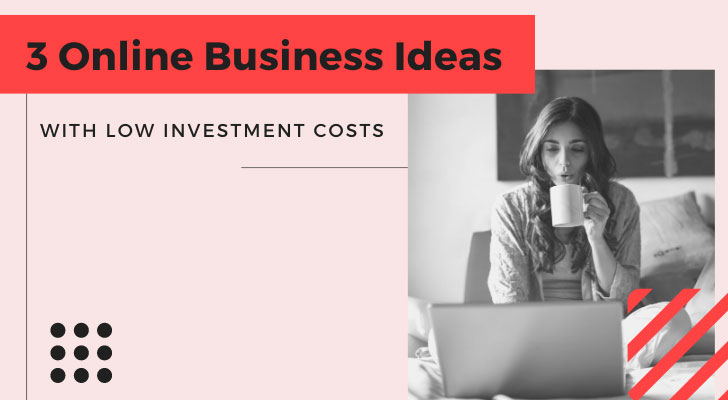Starting an online business doesn’t always require a massive budget. With some creativity and dedication, you can carve out a space for yourself and build something meaningful.
Here are three ideas that might spark some interest, especially if you’re looking for ways to invest little but potentially gain a lot.

1. Artisanal Creations
Many artisans pour their creativity into handmade goods that speak to their skills and style. People often gravitate toward handmade products because they feel more personal. It’s like buying a piece of the creator’s spirit, adding a level of attachment that mass-produced goods can’t offer.
If you enjoy working with your hands and creating, you might find this business idea fulfilling. With platforms like Etsy or even social media, it’s easy to get your creations in front of those who appreciate them. Whether you’re into woodworking, jewelry making, or crafting bespoke home decor, there’s a market for handmade items.
- Someone who loves knitting can sell scarves, hats, and sweaters in various designs.
- A leatherworker might craft custom wallets, belts, or bags, offering something more durable than the cheap items you find in stores.
- Pottery enthusiasts could focus on mugs, bowls, or even small sculptures that make everyday life a bit more special.
The trick here is to focus on something you truly enjoy making. This will allow you to produce goods that you can be proud of while also keeping the production costs low. Since most handmade businesses can be run out of your home, the overhead is minimal compared to renting a studio or a storefront.
Another aspect to keep in mind is that customers often love the story behind the product. It’s not just about what you make, but why you make it. Sharing that personal connection can draw people in and make your business stand out.
2. Spiritual Services and Goods
There’s growing interest in spiritual practices, ranging from meditation to energy healing. If you’re drawn to this area, there are many ways to build an online business that aligns with your interests. Whether it’s offering guidance, selling spiritual items, or conducting virtual sessions, this area can be explored in many ways.
You might start by selling items that are considered sacred or spiritual, such as crystals, incense, or essential oils. These types of products are often connected with wellness or mindfulness practices and have a broad appeal. Some people even prefer to buy from small business owners who offer a personal touch rather than large retailers.
- A person knowledgeable about different crystals could create a shop offering stones with descriptions of their properties.
- Someone versed in aromatherapy might craft custom oil blends for relaxation, sleep, or focus.
- Another option could be creating hand-poured candles with specific meanings or energies, connecting with the ritualistic side of candle use.
For those who enjoy direct interaction, offering virtual sessions, such as guided meditation, tarot readings, or energy healing consultations, could be a great way to build a personal connection with clients. With video conferencing tools, it’s easy to hold one-on-one sessions without needing physical office space.
There’s something to be said for sharing spiritual practices with others in a way that feels authentic to you. You don’t have to be an expert or a guru—just someone who genuinely wants to share what has worked for them. Whether you’re focused on wellness or creating a calm, reflective space for others, there’s a place for that online.

3. Personalized or Custom Goods
People love products that feel custom-made just for them. Personalization is a trend that keeps growing because it allows people to feel like they’re purchasing something more than just a product—it’s a reflection of who they are or what they care about. If you’re interested in this type of business, there are endless possibilities.
From custom clothing to engraved gifts, this business idea offers a chance to combine creativity with practicality. With access to online tools, suppliers, and digital design platforms, you don’t need to invest heavily to get started.
- A T-shirt designer could offer custom graphics or allow customers to submit their own designs for print-on-demand products.
- Someone with experience in engraving or laser cutting could craft personalized wooden plaques, jewelry, or keepsakes.
- A person who enjoys drawing could offer custom illustrations, whether it's portraits, pet drawings, or unique artwork based on someone’s preferences.
These types of products make great gifts, and people often pay a premium for something that feels exclusive to them or their loved ones. The beauty of this business is that it doesn’t require massive upfront investment. You can set up a website, market through social media, and begin taking orders without needing to stock a large inventory.
Offering personalized products allows customers to feel involved in the creation process. Whether it’s a custom message, design, or monogram, they get something more meaningful than an off-the-shelf item.

Wrapping it Up
Each of these business ideas comes with its own unique possibilities. Whether it’s creating artisanal products, offering spiritual services, or crafting personalized items, there’s room to explore and grow without needing a massive upfront investment. It’s all about choosing something you enjoy working on and finding ways to share that with others.
As you dive into any of these ideas, remember that the online world offers many platforms and resources to help you get started. From eCommerce platforms to social media marketing, there’s plenty of room to build something sustainable without breaking the bank.
Did You Know You Already Have A LOT To Sell?
So What's Your Problem?

